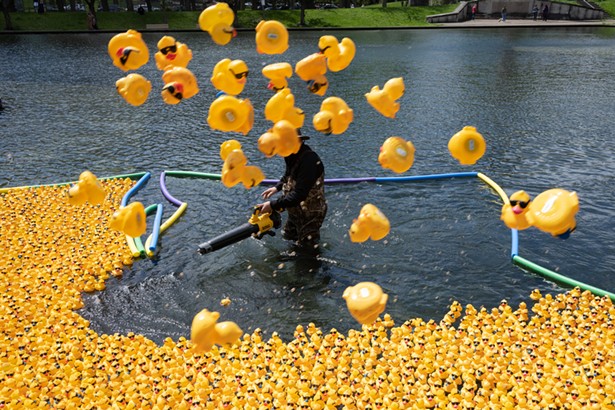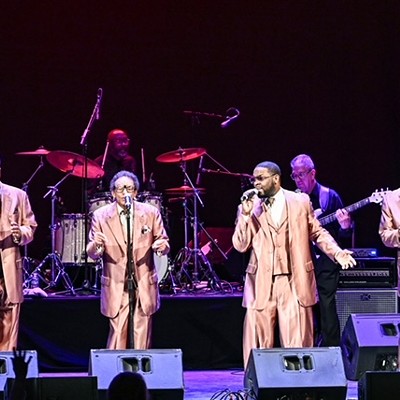If there's one place the dead never rest it's on the big screen, and Birth is no exception. Jonathan Glazer's brooding melodrama presents a discreetly made case for reincarnation, if only among the very best people.
A man is jogging through a deserted Central Park in the winter. The music is ominous, and perhaps we fear for his safety. Instead, he simply drops dead in a dark womblike tunnel, conveniently establishing the death = birth metaphor, as the film cuts to a fuzzy shot of a baby being born.
The film jumps ahead a decade: The jogger's widow, Anna (Nicole Kidman) is finally moving forward -- putting the dead man, Sean, in her past and embracing a new life with her financé Joseph (Danny Huston). But at their engagement party in a tony Upper East Side building, a 10-year-old boy appears and, with the gravity of a monk, tells Anna, "It's me, Sean. ... Don't marry Joseph." Anna shows the child -- whose name is indeed Sean -- the door, but the damage is done.
Sooner than you can say "never happen in real life," Sean keeps reappearing, gravely intoning more pleas of true love and recalling intimate details, and Anna begins to believe. Joseph understandably grows annoyed; other family members are openly contemptuous. Anna's mother, played by Lauren Bacall employing her trademarked high-tone hardness, growls at Sean during one of his inexplicable visits: "Are you enjoying your cake, Mr. Reincarnation?"
Glazer, the British ad and video director who made an impressive feature debut with 2000's stylish Sexy Beast, co-wrote this high-brow paranormal parlor drama with Milo Addica (Monster's Ball) and established French scribe Jean-Claude Carrií¨re. Birth, even with its languid pace, pokes its toe into some intriguing narrative waters but ultimately falls apart when it can't decide to root for logic or love eternal.
There's a perverse pleasure in seeing weird creepy things befall the very rich, those who normally glide through life insulated by wealth and privilege, a world of doormen, private elevators, hired cars and servants. The presence of the new Sean becomes a catalyst, the key that opens the family closet door, allowing a few discreet skeletons to clatter out.
Yet, the more the film plays out, the more illogical it all seems. The narrative, in its streamlined way, leaves many voids -- like Anna's history and inner life, so we never understand why Anna would tumble so quickly for such outrageousness. Another lost thread is what the presence of Sean reveals about Joseph (we know he's a bad choice because the camera often lingers on his overly pomaded hair). How does the new Sean know he's the old Sean? Are there other dead people floating about inside kids -- or is Sean the logical and singular result of Anna and her husband's undying love? And just who was that woman burying a box in Central Park during the engagement party?
The film is elegantly shot -- if at times slightly obvious (young Sean first sees Anna as she emerges from the darkness, lit only by the candles on a birthday cake). Glazer is deeply enamored of Manhattan's chilly winterscapes -- and how fortunate our protagonists are to live on the park with its attractively stark trees. The film's moody score by Alexandre Desplat cues much of the underlying emotion that rarely rises to the surface in these refined settings. There is one moment of high physical drama, but it occurs while underscored by a classical quartet -- quite literally.
Young Sean is played with determined gravitas by Cameron Bright, this year's go-to actor for spooked kids (Godsend, The Butterfly Effect). His Sean is nearly spectral -- all blank expression and a toneless voice. It's a bit hard to believe that if real Sean were trapped inside this child's body he couldn't make more of an emotional effort.
Kidman is well suited for these chilly, reserved roles; there's something naturally brittle about her. Glazer clothes her in muted colors, sleek and elegant, but she also sports a curious cap of a wig that combined with her slightly dazed demeanor makes her look like a passive victim rather than an active protagonist. Her hairdo also recalls Mia Farrow in Roman Polanski's 1968 Rosemary's Baby, another paranormal Manhattan melodrama, and one is tempted to suspect, like we did of Rosemary, that Anna may simply be mad (but if everybody else sees Sean, he must be there).
What starts out as a potentially interesting and provocative examination of memory, love and even rebirth comes to a curious point of finality, that, while the film's fantasy demands we dispense with hard logic, nonetheless is irritating in that this twist doesn't make sense. Suddenly, the puzzle pieces we've accumulated no longer hang together correctly. The denouement is a bit of a showman's trick that looks good in its initial flash, but ultimately negates the more engaging preamble.
So by its final enigmatic scene, Birth has puddled into a high-brow metaphysical trifle, a creepy movie keyed to the rarefied air of pre-war Manhattan domiciles -- entertaining to a certain point, but as wispy in meaning as one of Kidman's gorgeous cocktail gowns.















